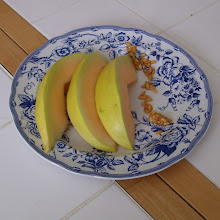Pas de basque was the first step in a combination across the floor in class on Saturday at Mark Morris Dance Center, Brooklyn. It's a step that can be very slow and luxurious, or it can be a quick waltz. The first time I recall encountering the quick-waltz version of the step was in a class taught by Mary Thompson in Cambridge, Mass. This step baffled me. Even though I knew how to do the slow pas de basque, there didn't seem to be enough counts for the quick one. I was used to the step taking four counts, with a rond de jambe--circling the leg from front to back--on the first count. In the quick version, you need to rond de jambe and step forward on count one in order for it to work, and I mostly found this out because it didn't work for me.
So this Saturday, I knew how to pas de basque quickly. My memories of Mary's pas de basque combinations returned. Yet the memory of being nervous about doing pas de basques and losing a count or a step and not knowing why in Cambridge was somehow pleasant. A familiar memory was pleasant, even though the experience remembered was one of anxiety.
I thought of Mary when we did balancés toward the back corners of the room. Dancing toward the back corner in combinations that ultimately travel forward seemed counter-intuitive to me, but it comes up all the time, and I'm ready for it. I thought of her when we did pas de chats. Mary said that the height of the jump, in which you move sideways and bring both feet under you one after the other, was determined by how much your torso rose, not how high you got your bent legs off the ground.
As we did circular port de bras, rotating the upper body in a circle around the hips, I remembered how my friend and I used to try to look at the floor the whole time, a feat quite difficult when you are bending straight back. It's a challenge that goes along with using your head in the port de bras, since if you can't bend your back any further, as any limbo player knows, you can always throw back your head. Actually, looking at the floor helped me keep my balance during the port de bras, whereas just using my head without looking at anything made me fall over, or at least feel like I was going to.
Though these steps may not be familiar to all readers of this blog, they have layers of familiarity for dancers. Ballet class, which has the same format every time, everywhere, is a routine in itself. Then come the memories of all the teachers and what they've said about various steps. "Exhale as you go forward," one teacher said every time we did a bend forward at the barre. I think she just liked saying it; surely everybody caught on after she said it a few times, since it's an easy correction to apply!
So during that circular port de bras, exhale as you go forward, don't cut corners, use your head, and try to see the floor the whole time! And don't get too lost in daydreams.
Subscribe to:
Post Comments (Atom)

No comments:
Post a Comment